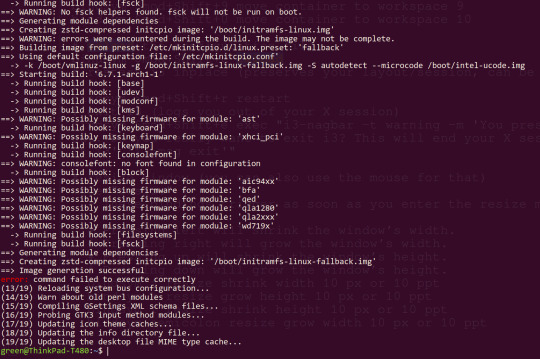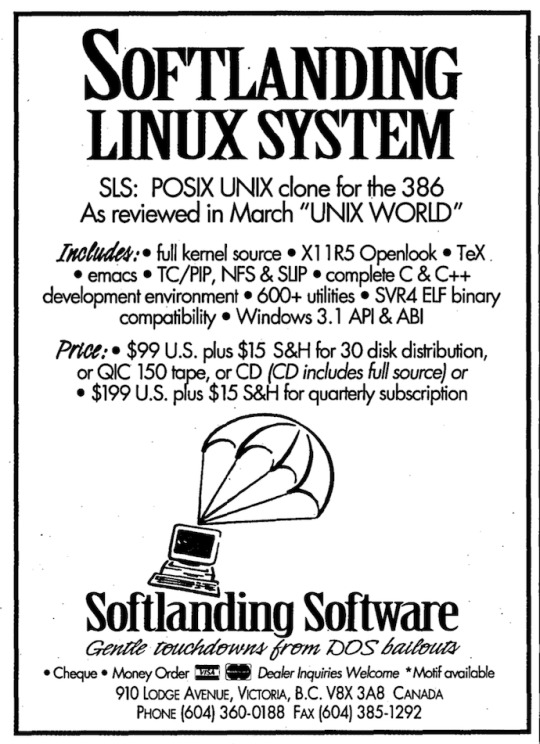#linux kernel
Explore tagged Tumblr posts
Text
How many different versions of the Linux kernel do y'all have ready to boot into? Personally, I have three just in case something goes wrong.
31 notes
·
View notes
Text
I just spent 10 minutes trying to figure out why the new kernel I installed wasn't showing up in GRUB. It tends to help if I actually have the grub-mkconfig command actually output to grub.cfg so GRUB will recognize it.
22 notes
·
View notes
Text
Unlocking the Future with Android 14 on Toradex Verdin AM62: Introducing Our Custom GStreamer Plugin
We at Silicon Signals are excited to share our most recent accomplishment: the successful deployment of Android 14 on the Dahlia Carrier Board of the Toradex Verdin AM62 System on Module (SoM). This achievement not only expands the Verdin AM62 platform's functionality but also gives developers access to our proprietary GStreamer plugin, which gives them previously unheard-of flexibility and control.
Standard vs. Silicon Signals Custom GStreamer Plugin
The integration of our proprietary GStreamer plugin, which greatly improves the media rendering experience, is one of our implementation's most notable features. The following differs our Silicon Signals solution with conventional implementations:
youtube
Standard
Silicon Signals Custom GStreamer Plugin
Location Control
Random Location
Exact X, Y Coordinates
Time Efficiency
Time Consuming
Quick Setup with Precise Placements
Control Flexibility
Limited Control
Custom Coordinates and Full Control
Rendering Consistency
Unpredictable
Consistent Results with Defined Parameters
For developers, standard implementations frequently lead to unpredictable and time-consuming video rendering locations. Silicon Signals, on the other hand, gives developers exact control over rendering through our proprietary plugin, which enables them to set precise X and Y coordinates for video placement. Applications that demand a high level of accuracy and dependability are made possible by this flexibility, which guarantees consistent results.
Conclusion: Powering Innovative Solutions
Developers now have more options thanks to the successful port of Android 14 to the Toradex Verdin AM62 using the Dahlia Carrier Board. When used in conjunction with our proprietary GStreamer plugin, this solution gives you unparalleled control and precision when creating media-rich applications.
At Silicon Signals, we're committed to expanding the possibilities of embedded systems and assisting our customers in realizing their visions. Please get in touch with us if you would like to discuss how our solutions can improve your projects!
Let's work together to influence embedded technology's future.
#embeddedtechnology#embeddedsoftware#linux kernel#android#androidbsp#verdin#toradex#nxp#imx#gstreamer#Youtube
2 notes
·
View notes
Text

okay this is scary... the `pacman -Syu` command failed on upgrading the kernel 0_0
3 notes
·
View notes
Text
OpenAI’s o3 Model Helps Researcher Discover Critical Zero-Day Linux SMB Vulnerability
Introduction In a breakthrough for AI-assisted cybersecurity, researcher Sean Heelan successfully uncovered a critical zero-day vulnerability in the Linux kernel’s Server Message Block (SMB) stack using OpenAI’s advanced o3 AI model. This previously unknown security flaw, now tracked as CVE-2025-37899, involves a use-after-free bug in the Linux SMB ‘logoff’ command handler and poses serious…
#AI in security#binary exploitation#cybersecurity#Linux kernel#o3 model#OpenAI#Sean Heelan#SMB vulnerability#use-after-free#zero-day vulnerability
0 notes
Text
Comparative review of best #WiFi Adapters with monitor mode and packet injection capabilities for #KaliLinux for real-world.
#aircrack-ng#Atheros AR9271#Cracking#Driver#GUI#Hashcat#Kali Linux#Linux#Linux Kernel#monit#Monitor#monitor mode#Monitoring#N600#packet injection#PCI#Penetration Test#penetration testing#Pyrit#Reaver-WPS#Recommended#RTL8812AU#RTL8814AU#Security#Security Audit#TP-Link#Troubleshooting#Virtualbox#wireless#Wireless Cards
0 notes
Text
Launching the Simics Simulator with RISC-V Platform

The amount of processor cores, active instruction set extensions, memory capacity, virtual disk size and content, Ethernet network address, and other configuration options can all be changed on hardware. The platform employs virtio devices for networking, drives, and entropy (instead of devices from some particular real-world RISC-V-based system-on-chip (SoC)) to simplify program support. Practically speaking, it feels and appears like a little embedded device, despite the fact that it may be configured with many gigabytes of disk and RAM.
Both Linux and bare-metal software can be executed on the platform. Buildroot is used to build the standard software stack for Linux. Creating a bootloader, Linux kernel, and bootable file-system image for the RISC-V virtual platform is a pretty simple task when you use Buildroot.
Connecting the Virtual Platform RISC-V
Enabling networking was a fairly intriguing use case throughout the platform’s development. It wasn’t difficult to get networking to function at the point where machines could “ping” one another. It required some effort to enable remote login from one computer to another.
Telnet would have been used to accomplish this in the past. There is minimal configuration required, and the protocol, client, and server are all straightforward. But the networking world isn’t what it used to be, and almost every Linux distribution demands that secure shell (SSH) be used for any form of remote login. It only takes a few lines of setup to add SSH to Buildroot, then rebuild.
SSH, however, is a more intricate creature. After adding SSH to the root filesystem, the target machine would not start up and would hang right before the login prompt appeared. The absence of unpredictability was the issue. SSH requires a source of randomness in order to produce a host key when it is first installed. The random pool was filling up very slowly since the Linux kernel could not find many sources of randomness to use on the very basic virtual platform. stopping the boot’s advancement. Nice example of “oh, I didn’t realize that might be an issue.”
Intel enhanced the target system by adding a “Virtio entropy” device. This gives the target system a high-bandwidth source of randomness. To assure simulation repeatability, it is implemented in the simulator using a deterministic pseudorandom system, even if it appears to the target system to be a hardware random-number generator (RNG). The variation is undetectable to the target software.
This is a straightforward simulated network architecture that makes use of several RISC-V virtual platforms, each with a unique hardware arrangement. It should be noted that the virtual network also has a “service node” that offers standard services like DHCP for system configuration and a dependable target for ping to check network connectivity.
SSH is being used by the “small” machine to connect to the “medium” machine. To display the memory size, the “medium” and “large” machines are both operating at the top. In order to show the simulation of a multicore target system, they are also running a few copies of the single-threaded coremark benchmark. A list of the simulated machines and every processor core in the active simulation is displayed by the Simics simulator command line.
The target machines differ in terms of clock frequencies, memory sizes, and core counts, as can be seen from the Simics command-line interaction in the terminal.
Because each RISC-V target is housed in a separate Simics simulator cell, the simulation can run three machines concurrently, which speeds up the simulation. Additionally, each machine has the option to activate parallel simulation, which might result in the creation of two + four plus eight, or 14-way parallelism in this instance. Workloads involving a lot of computation benefit greatly from this acceleration.
Using the Quick Start Platform for networking
Heterogeneous mixed-architecture simulations can be conducted since the Intel Simics Simulator Public Release includes the Intel Architecture-based Quick-Start Platform (QSP). Combining the two targets into a single network within a single Simics simulation operation is a basic example. similar to this
The service node’s Network Address Translation (NAT) feature allows any virtual network to be connected to the outside world. The screenshot below shows the host system (this time running Microsoft Windows for variety’s sake) logging into the RISC-V target system via inbound port forwarding with an SSH client. Additionally, two SSH connections are open due to an SSH login from the QSP target system to the RISC-V target system..
All that is required to set this up is a short amount of top-level scripting over the virtual platform scripts that are already in place. Initially, default parameter values that deviate from the targets’ standard values are set up using a YAML file. Keep in mind that the exact names of the parameters and the parameter hierarchy may vary because this is based on early drops of the targets.
Second, the YAML file calls a Simics simulator command-line script, which uses pre-existing setup scripts to produce the separate setup components in order to build the network and target systems.
Read more on Govindhtech.com
0 notes
Text

#programmerhumor#linuxmemes#codinglife#devops#sysadmin#buglife#softwareengineering#bash#linux#linuxposting#git#vim#emacs#kernel#ubuntu#debian#archlinux#serverlife#cloudcomputing#programmingfails#linuxproblems#csjokes#coderlifememes#sysadminstruggles#chilean#chilensis#chileno#tumblr chilenito#valparaiso#chile fotos
414 notes
·
View notes
Text
Woo got Linux working! On a related note I have gotten over any fear of breaking things through the command line and also can now roll back to an earlier system backup. Yes those are related. In my defense, breaking things in interesting ways is a great way to figure out what's actually going wrong.
#Had issues getting my trackpad to work and went through All The Drivers#thank you that one redditter who went through this same thing six months ago and figured out that installing a previous kernel fixed it#Official documents out random redditter in#RIP Windows 11 I shall not miss the 4 times you managed to force updates in the two non-consecutive hours I used you#Nor how each update progressively added more unwanted ad junk and invasive features#Save me Linux-Wan you're my only hope#The Cinnamon desktop seems adorable I'm looking forward to playing with its features tomorrow#Wow it's been awhile since a new OS has been exciting#Instead of Oh What Fresh Hell Is This
89 notes
·
View notes
Text
19 notes
·
View notes
Text
Made a minor mistake that I'll likely end up repeating at some point down the line: I forgot to install the headers for the kernel I just installed, so I couldn't install the DKMS modules for it, meaning my graphics card drivers (nvidia-dkms) simply didn't work. Issue has since been corrected.
0 notes
Text
Linux Kernel Debugging Guide
3 notes
·
View notes
Note
What are your thoughts on completely reimplementing the Linux kernel in c++
I mean if you're gonna rewrite it, why not in @rust-official? (and im not just saying this because the person behind the tumblr account is so cool)
38 notes
·
View notes
Text
i randomly found my matching ram at the cashies for 10$ today so now i'm up 2 32gb of ram.
time 2 compile many many things
38 notes
·
View notes

